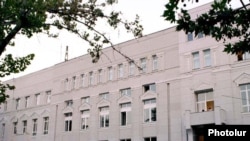Both the bank and the Armenian government forecast late last year and early this a GDP growth of only 1.2 percent for 2010, citing the lingering impact of the global financial crisis on the domestic economy. The government revised the forecast to 1.8 percent in early April, shortly before recording a year-on-year GDP rise of 5.5 percent in the first quarter of the year.
The Central Bank will come up with a less conservative estimate in its quarterly macroeconomic policy report to be made public on Thursday. Artur Stepanian, the head of the bank’s Department on Fiscal-Monetary Policy, divulged details of the report to RFE/RL’s Armenian service on Wednesday.
“The expansionist fiscal-monetary policies implemented in 2009 as well as a faster-than-expected global economic recovery … are resulting in very positive trends in Armenia,” said Stepanian. “While we forecast a [full-year] growth rate of 1.2 percent in January, we now expect it to come in at between 3 and 4 percent.”
The stronger-than-expected growth primarily resulted from a roughly 10 percent rise in industrial output, which was in turn boosted by rallying international prices of copper and other non-ferrous metals, Armenia’s most important export item. A 6 percent growth in services other than retail trade also reflected positively on the country’s first-quarter macroeconomic performance.
According to Stepanian, economic growth should remain relatively strong in the coming months also because of rising remittances from scores of Armenians working abroad. He said the vital cash transfers were up by over 8 percent on the year in the first quarter.
“We expect that the growth in remittance inflows will accelerate,” Stepanian added, predicting a full-year rise of 14-15 percent.
One of the consequences of the renewed growth has been a surge in consumer price inflation. Official statistics show the first-quarter consumer price index rising by 8.4 percent and nearly twice exceeding the 2010 target rate set by the government and the Central Bank. The latter has responded to rising inflation by substantially raising its benchmark re-financing rate since January.
Stepanian said the Central Bank report predicts that the inflation rate will fall to 6.2 percent by the end of 2010. Prime Minister Tigran Sarkisian likewise said last month that inflationary pressures on the Armenian economy will ease in the coming months.
The authorities say increased international prices of basic foodstuffs, fuel and other commodities imported to Armenia are mainly responsible for the high inflation. But some independent economists and consumer rights groups blame a de facto monopoly enjoyed by the country’s leading importers mostly connected to the government.
Abgar Yeghoyan of the non-governmental group Protection of Consumer Rights complained on Wednesday that a strengthening of the national currency, the dram, observed in recent weeks has not pushed down the prices of key imported goods. Speaking to RFE/RL, Yeghoyan argued that they went up considerably when the dram weakened against the U.S. dollar and the euro in February-March.
The Central Bank’s Stepanian acknowledged that a “high level of monopolization” of the Armenian economy and the resulting “price rigidity” have an impact on inflation. “That means prices rise very quickly and are quite slow in falling back,” he said.




